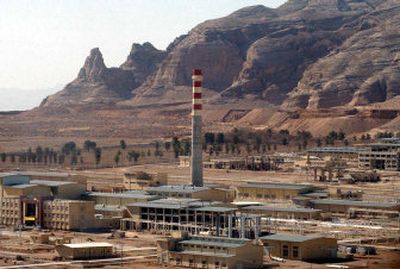Uranium plant back in business

Isfahan, Iran
Iran resumed full operations at its uranium conversion plant Wednesday, as Europe and the United States struggled to find a way to stop the Islamic republic from pushing ahead with a nuclear program they fear will lead to weapons of mass destruction. With United Nations inspectors watching, Iranian officials removed U.N. seals that had been placed voluntarily on equipment at the facility eight months ago when Tehran agreed to freeze most of its nuclear program. Technicians then immediately resumed work on the process that turns raw uranium into gas for enrichment.
Iran has rejected European proposals to limit its program in return for economic incentives and shrugged off threats of U.N. sanctions. Any attempt to impose sanctions could face a veto in the U.N. Security Council from Russia and China.
Roadside bomb kills American soldier
Kabul, Afghanistan
A U.S. service member was killed by a roadside bomb in eastern Afghanistan, the military said Wednesday, raising to five the number of Americans killed in less than a week as violence escalates ahead of next month’s parliamentary elections.
Elsewhere, an Afghan villager claimed a woman and child had died in a coalition airstrike during fighting earlier in the week.
The bomb exploded Tuesday near a vehicle in eastern Ghazni province where an American unit was conducting operations to “disrupt enemy activity in the region,” the military said.
Two American troops were evacuated to the main U.S. base at Bagram, north of Kabul; one died shortly after arrival while the other was in stable condition.
Three U.S. troops and an Afghan interpreter also were wounded in a clash at a cave complex near Wazikwa in eastern Patika province, the military said. Six militants died in the fighting.
Sporadic attacks across the country have deepened concerns over security ahead of key legislative elections set for Sept. 18. The vote represents the country’s next step toward democracy after two decades of war and civil strife.
Climber plucked from Himalayan ledge
Islamabad, Pakistan Stripped of excess weight to fly in the thin Himalayan air, an army helicopter Wednesday plucked a Slovene climber from the icy ledge where he was trapped for six days after failing to climb an unconquered face of Pakistan’s “Killer Mountain.”
Tomaz Humar, 36, was hoisted to safety from Nanga Parbat mountain after two earlier helicopter rescue attempts failed because of high altitude and poor weather.
Humar, who remained in radio contact with his base camp during his ordeal, returned there around 6:30 a.m. He was dehydrated, hungry and showing early signs of frostbite but suffering no serious health problems, according to a posting on his expedition Web site.
Pakistan’s military hailed the rescue as a “highly daring and extraordinary mission” conducted above the normal ceiling for flying – and rivaling its 1983 rescue of a Belgian mountaineer in the Himalayas from 22,000 feet.
Two Lama aircraft were stripped of “optional equipment,” the army said. Neither was able to land, so one chopper dropped a sling to him and carried him away, dangling from a rope.
The army said Humar had been stranded at 21,520 feet, but his Web site said he had descended to about 19,470 feet.
Humar, a customs officer who lives in Stranje, Slovenia, was climbing Nanga Parbat – which means “Naked Mountain” in Urdu – via its unconquered Rupul Face.
Nanga Parbat, listed by the World Almanac as the world’s 10th highest peak at 26,660 feet, is more widely known as “Killer Mountain.” In all, 31 people died attempting to reach the summit before it was conquered by Herman Buhl in 1953.